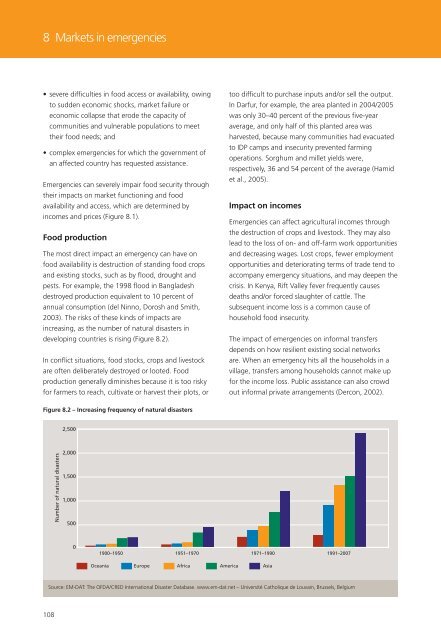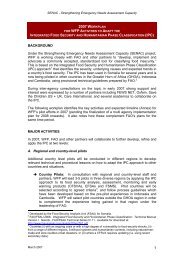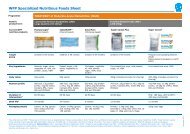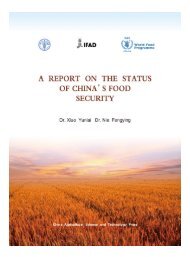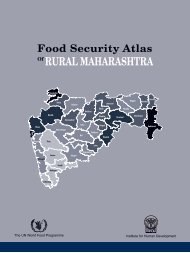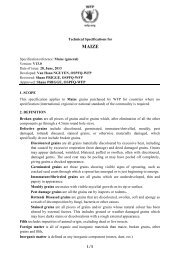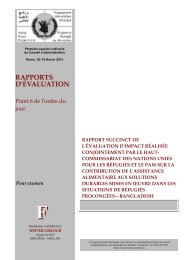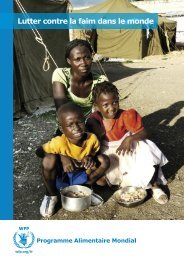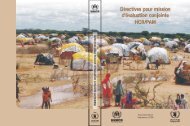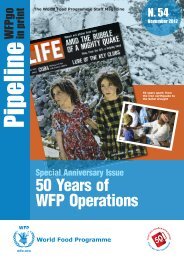World Hunger Series Hunger and Markets - WFP Remote Access ...
World Hunger Series Hunger and Markets - WFP Remote Access ...
World Hunger Series Hunger and Markets - WFP Remote Access ...
You also want an ePaper? Increase the reach of your titles
YUMPU automatically turns print PDFs into web optimized ePapers that Google loves.
8 <strong>Markets</strong> in emergencies• severe difficulties in food access or availability, owingto sudden economic shocks, market failure oreconomic collapse that erode the capacity ofcommunities <strong>and</strong> vulnerable populations to meettheir food needs; <strong>and</strong>• complex emergencies for which the government ofan affected country has requested assistance.Emergencies can severely impair food security throughtheir impacts on market functioning <strong>and</strong> foodavailability <strong>and</strong> access, which are determined byincomes <strong>and</strong> prices (Figure 8.1).Food productionThe most direct impact an emergency can have onfood availability is destruction of st<strong>and</strong>ing food crops<strong>and</strong> existing stocks, such as by flood, drought <strong>and</strong>pests. For example, the 1998 flood in Bangladeshdestroyed production equivalent to 10 percent ofannual consumption (del Ninno, Dorosh <strong>and</strong> Smith,2003). The risks of these kinds of impacts areincreasing, as the number of natural disasters indeveloping countries is rising (Figure 8.2).In conflict situations, food stocks, crops <strong>and</strong> livestockare often deliberately destroyed or looted. Foodproduction generally diminishes because it is too riskyfor farmers to reach, cultivate or harvest their plots, ortoo difficult to purchase inputs <strong>and</strong>/or sell the output.In Darfur, for example, the area planted in 2004/2005was only 30–40 percent of the previous five-yearaverage, <strong>and</strong> only half of this planted area washarvested, because many communities had evacuatedto IDP camps <strong>and</strong> insecurity prevented farmingoperations. Sorghum <strong>and</strong> millet yields were,respectively, 36 <strong>and</strong> 54 percent of the average (Hamidet al., 2005).Impact on incomesEmergencies can affect agricultural incomes throughthe destruction of crops <strong>and</strong> livestock. They may alsolead to the loss of on- <strong>and</strong> off-farm work opportunities<strong>and</strong> decreasing wages. Lost crops, fewer employmentopportunities <strong>and</strong> deteriorating terms of trade tend toaccompany emergency situations, <strong>and</strong> may deepen thecrisis. In Kenya, Rift Valley fever frequently causesdeaths <strong>and</strong>/or forced slaughter of cattle. Thesubsequent income loss is a common cause ofhousehold food insecurity.The impact of emergencies on informal transfersdepends on how resilient existing social networksare. When an emergency hits all the households in avillage, transfers among households cannot make upfor the income loss. Public assistance can also crowdout informal private arrangements (Dercon, 2002).Figure 8.2 – Increasing frequency of natural disasters2,500Number of natural disasters2,0001,5001,00050001900–1950Oceania1951–1970 1971–1990 1991–2007Europe Africa America AsiaSource: EM-DAT: The OFDA/CRED International Disaster Database. www.em-dat.net – Université Catholique de Louvain, Brussels, Belgium108


